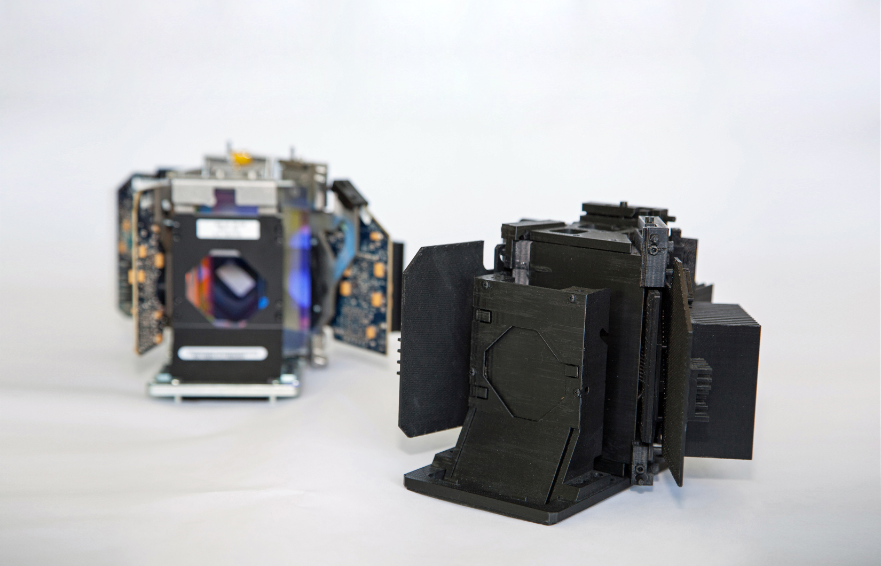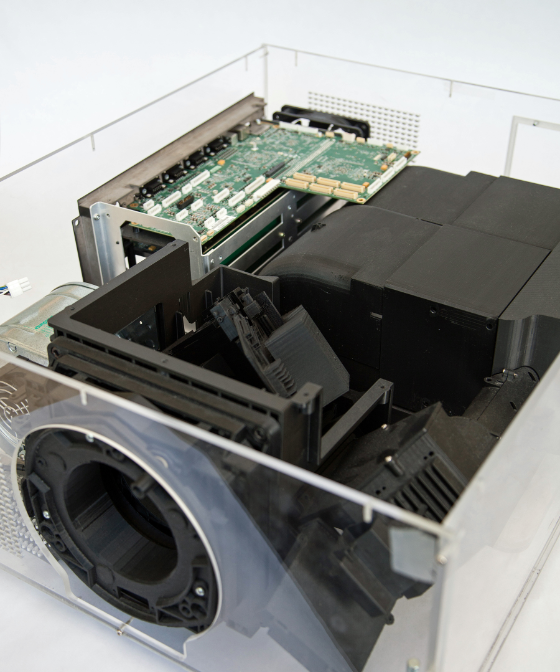“Build, test, optimize. That is our motto,” said Mark Barfoot, senior manager for Christie Digital Systems, which manufactures advanced digital projectors and displays. That philosophy of constant improvement drives Christie’s innovative prototyping program. Barfoot credits the strategy for Christie’s ability to meet customer needs with the very first shipment of each new product. The company serves demanding clients in cinema, large audience environments, 3D and virtual reality, simulation, education, media and government.
Additive manufacturing, also known as 3D printing, is vital to Christie’s approach. The technology lets engineers complete numerous design iterations quickly. Barfoot says the speed gains go toward improving products, rather than rushing to market with anything less than a perfect design. Because prototyping needs change as a product’s design matures from concept through functional testing, Christie deploys two distinct additive manufacturing methods from Stratasys: Fused Deposition Modeling (FDM) Technology and PolyJet technology. “There isn’t a single best additive manufacturing technology,” Barfoot said. “That’s why we have both FDM and PolyJet.”
Christie invested in FDM because it can 3D print in the same durable thermoplastics found in finished goods, and for its user-friendly interface that makes it easy to operate. The company added PolyJet technology to make finely detailed overmolded parts with rubberlike components. Christie’s M Series projector is one of many examples where the product development team used both technologies. Early in the project, Christie 3D printed initial design concepts with PolyJet, which builds parts fast. “At this point, everything is fluid, so having evaluation pieces quickly is a must,” Barfoot said. As designs solidified, engineers built an FDM assembly with individual surrogate parts representing everything from air intakes to printed circuit boards to optics to the $10,000 light engine. The mock-up grew to look more like the finished product as sourced and manufactured components became available, replacing 3D printed surrogates.
“That mock-up was our baseline communication piece throughout the project,” said Barfoot. The engineering team again turned to PolyJet to evaluate designs of projector components like the overmolded handle, projector keypad and rubber lensmount boot. Barfoot says the technology was especially useful in fine-tuning the projector’s remote control with a rigid case and soft buttons, which emerge from Christie’s Connex 3D printer all in one piece. “It truly was a functional prototype,” he says. Before PolyJet, the remote control would have been rubber molded, at a cost of $2,000 and two weeks per iteration. Christie did three revisions in three days for less than $500.
FDM was the only choice to prototype the projector’s air exhaust baffle. Its S-shaped path is complex by design, to trap light without restricting air flow. Air as hot as 150˚ C (302˚ F) would flow through the prototype, so heat resistance was required along with geometric complexity. Engineers 3D printed the baffle in polyphenylsulfone (PPSF) thermoplastic. For the lamp assembly, which operates at 120˚ C (248˚ F), Christie used ULTEM™ 9085 resin. “We have had a mindset change with our engineers. Now they are not willing to live with one prototype and hope it works. They are iterating daily to make sure they are getting the most optimum design,” Barfoot said.
Beginning with the purchase of its FDM technology-based 3D printer eight years ago, Christie has invested in a variety of resources with the aim of building a state-of-the-art prototyping and environmental testing program. This empowers its engineers to develop the best possible display devices, and Christie is now offering its “build, test, optimize” capabilities to other industries. In the heart of Canada’s technology triangle, Christie’s new enterprise, Hyphen, offers the country’s widest range of prototyping and environmental testing services under one roof. Through Hyphen, Christie shares its methods and technology to give other companies the benefit of its iterative approach to product development. Hyphen also shares Christie’s next mindset change: 3D printing for final part production. Barfoot, who is also managing director for Hyphen, said, “We are seriously looking at direct digital manufacturing for high-end products that have annual shipments of less than a hundred units.”

